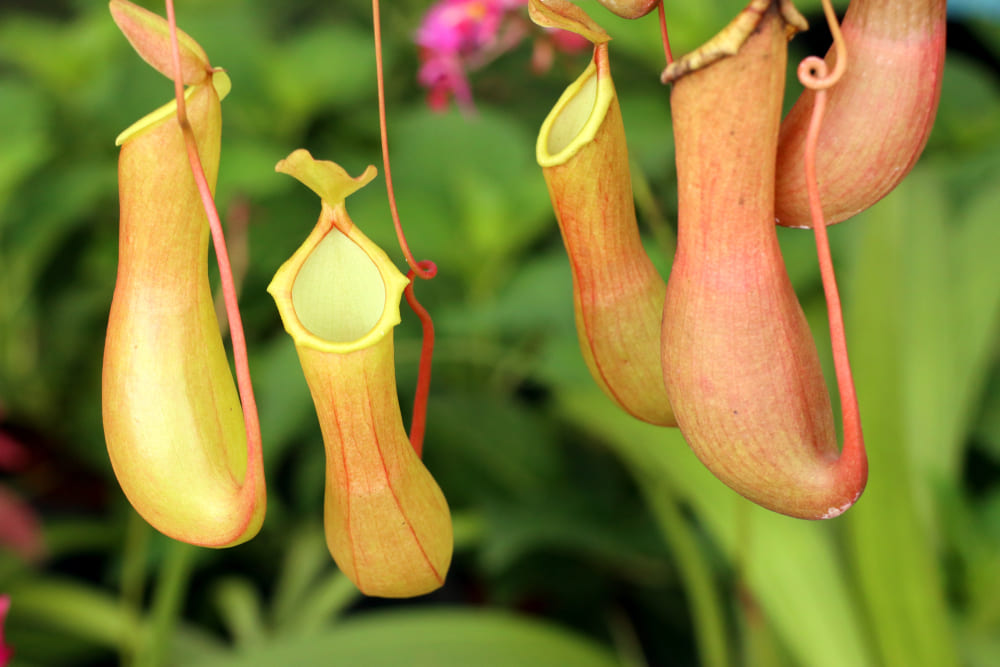So, the next time you wonder, “Should I put water in my pitcher plant?” – the answer is a definite yes! Provide your pitcher plant with the appropriate water supply, and watch it flourish in its carnivorous glory.
Pitcher plants are fascinating and unique carnivorous plants that capture and digest insects.
These plants have specialized leaves called pitchers, which form a natural trap to lure and consume their prey.
The Watering Needs of Pitcher Plants

Like any other living organism, pitcher plants require water to survive and thrive. Water is essential for their metabolic processes, nutrient absorption, and overall health.
While pitcher plants possess specialized adaptations to obtain nutrients from insects, they still rely on water to maintain their physiological functions.
The unique structure of pitcher plants allows them to capture rainwater, which acts as a natural source of hydration.
In their natural habitats, pitcher plants often collect rainwater in their pitchers, providing them with a sufficient water supply.
When grown indoors or in environments with limited rainfall, you may need to take an active role in watering your pitcher plant.
The Significance of Proper Watering
Ensuring proper watering is crucial for the well-being of your pitcher plant. Without adequate hydration, the plant may suffer from various issues, such as dehydration, wilting, and stunted growth.
Water deficiency can also hinder the plant’s ability to produce healthy pitchers and attract prey, hindering its carnivorous nature.
On the other hand, overwatering can be equally detrimental to pitcher plants.
Excessive moisture can lead to root rot, fungal infections, and the deterioration of the pitcher’s trapping mechanism.
It is essential to strike a balance between providing enough water to meet the plant’s needs while avoiding waterlogged conditions.
How to Water Your Pitcher Plant
Watering pitcher plants requires a delicate balance to replicate their natural habitat. Here are some tips to help you ensure your pitcher plant gets the right amount of water.
1. Use Distilled or Rainwater
Pitcher plants are sensitive to chemicals commonly found in tap water, such as chlorine and fluoride.
These chemicals can harm the plant and disrupt its natural functioning. It is best to use distilled water or rainwater, as they are free from harmful substances.
2. Water from the Bottom
Rather than pouring water directly into the pitcher, it is recommended to water the plant from the bottom.
Fill a tray or saucer with distilled or rainwater and place the pot in it. This method allows the plant to absorb water through its roots naturally.
3. Monitor Moisture Levels
Pitcher plants prefer moist but not waterlogged soil. Ensure that the soil remains damp, but not overly saturated.
You can use a moisture meter or simply feel the top inch of the soil with your finger. If it feels dry, it’s time to water the plant.
4. Consider the Environmental Factors
Factors such as temperature, humidity, and air circulation can influence the watering needs of your pitcher plant.
Higher temperatures and lower humidity levels may require more frequent watering, while cooler temperatures and higher humidity levels may require less.
Consequences of Neglecting Watering Needs
Neglecting the watering needs of your pitcher plant can have adverse effects on its health and well-being. Here are some potential consequences of improper watering:
1. Dehydration and Wilting
Insufficient water supply can lead to dehydration and wilting of the pitcher plant. The leaves may lose their turgidity, become droopy, and develop brown or yellow discoloration.
Without proper hydration,the plant’s overall vitality and ability to attract insects for nourishment will be compromised.
2. Stunted Growth
Lack of adequate water can hinder the growth and development of your pitcher plant. The plant may exhibit slower growth rates, smaller pitchers, and a general lack of vigor.
It needs a consistent water supply to support its metabolic processes and promote healthy growth.
3. Reduced Carnivorous Function
Pitcher plants rely on their unique trapping mechanism to capture and digest insects.
Without sufficient water, the pitchers may become dry and lose their stickiness, making it difficult for the plant to attract and trap prey.
This can significantly impact the plant’s ability to fulfill its carnivorous nature.
4. Susceptibility to Pests and Diseases
When a pitcher plant is stressed due to inadequate watering, it becomes more susceptible to pests and diseases.
Stressed plants are more attractive to harmful insects and pathogens, which can further weaken the plant’s overall health. Proper watering helps maintain the plant’s natural defense mechanisms.
FAQ: Should I Put Water in My Pitcher Plant
Should I put water in my pitcher plant?
Answer: Yes, pitcher plants require water to thrive.
Is water necessary for pitcher plants?
Answer: Absolutely, pitcher plants need water for survival and proper growth.
Can I skip watering my pitcher plant?
Answer: No, regular watering is crucial for the health of pitcher plants.
How often should I water my pitcher plant?
Answer: Water your pitcher plant when the soil feels slightly dry, usually once or twice a week.
What type of water should I use for my pitcher plant?
Answer: Use distilled or rainwater for pitcher plants to avoid harmful minerals found in tap water.
Conclusion
Watering your pitcher plant is vital for its well-being and carnivorous functionality.
By understanding the watering needs of pitcher plants and employing proper techniques, you can ensure the plant receives the hydration it requires to thrive.
Remember to use distilled or rainwater, water from the bottom, monitor moisture levels, and consider environmental factors.
Neglecting the watering needs of your pitcher plant can result in dehydration, stunted growth, reduced carnivorous function, and increased vulnerability to pests and diseases.
